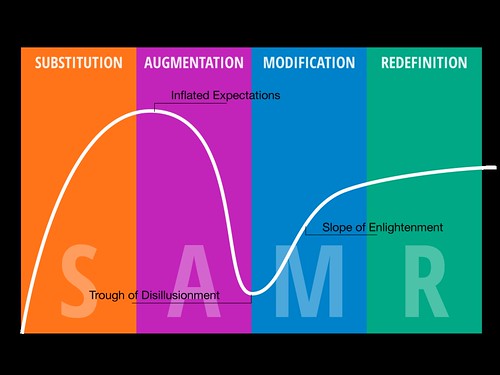 At NETA I met many great teachers all interested in finding new ways to integrate technology into their instruction. It was great seeing so many familiar faces, especially since five years ago during my first visit I did not know many of the participants.
At NETA I met many great teachers all interested in finding new ways to integrate technology into their instruction. It was great seeing so many familiar faces, especially since five years ago during my first visit I did not know many of the participants.One of the teachers who stopped by our poster on thursday afternoon confided: "I know I need to use some of this for my students. I have a facebook page but I never post. People get fired over facebook posts." This comment is not new, I actually hear it quite often from teachers who seem paralyzed by the fear of technology. I actually have even discussed it before on this blog. Thei frustration seems to grow as they seem to be afraid but also pushed to integrate technology. They feel between a rock and a hard place- and thus frustrated.
This time I just got curious about the phenomena and whether there really was an epidemic of social media firings. I used Google to try and ferret out exactly how many teachers have been reported being fired because of social media activity in the last year. For all the media and teacher hype I found very few actual cases of full time teachers fired.
1. In Smithville Ohio a teacher got fired over a post on Dairy farming. He was let go by the local school board but reinstitated (with back pay) after a short court battle. More here and here
 2. Texas teacher from Duncanville resigned over an inflamatory tweet here. It was quite extreme and she resigned.
2. Texas teacher from Duncanville resigned over an inflamatory tweet here. It was quite extreme and she resigned.3. Ashley Payne resigned over facebook pics. See here. The main point was that she has resigned and was not fired (unlike most of the headlines)
There were a few cases of substitute teacher "firing" mostly over posting of student photos.
So is there room to worry?
I would argue that anyone needs to be careful about social media and be a good citizen (not just digital).
But
1. Given 3.4 million K12 public school teachers around the country and with most on Facebook the incidence of firing seems to be extremely small.
2. Teachers should not resign without legal council
3. Read your district guidelines especially about posting photos of students
Consult this page from the NEA
Remember that as a prospective teacher you need to excerice more caution.
Do not let this stop you from participating in thoughtful technology integration your students will be missing out.










